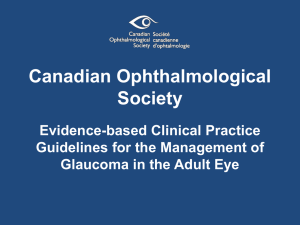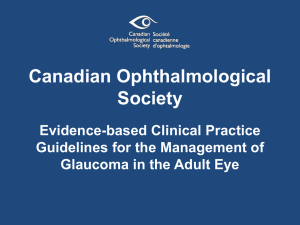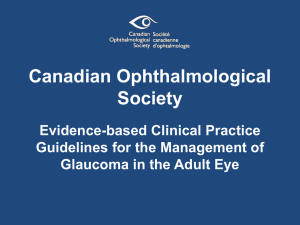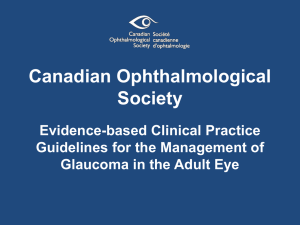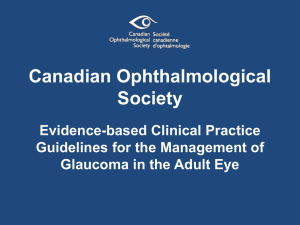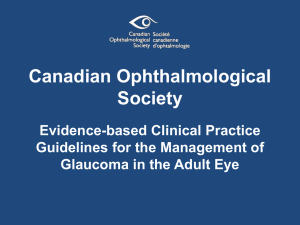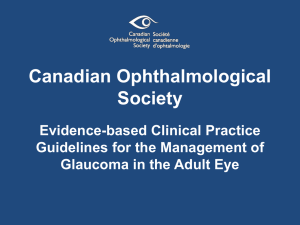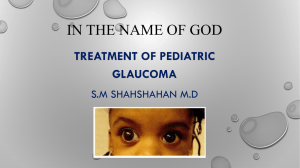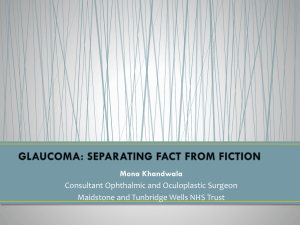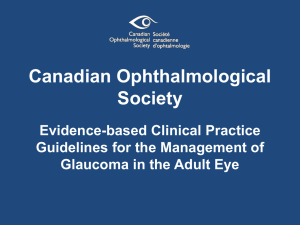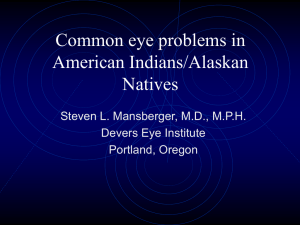GlaucomaGuidelines-Intro-epidemiology
advertisement
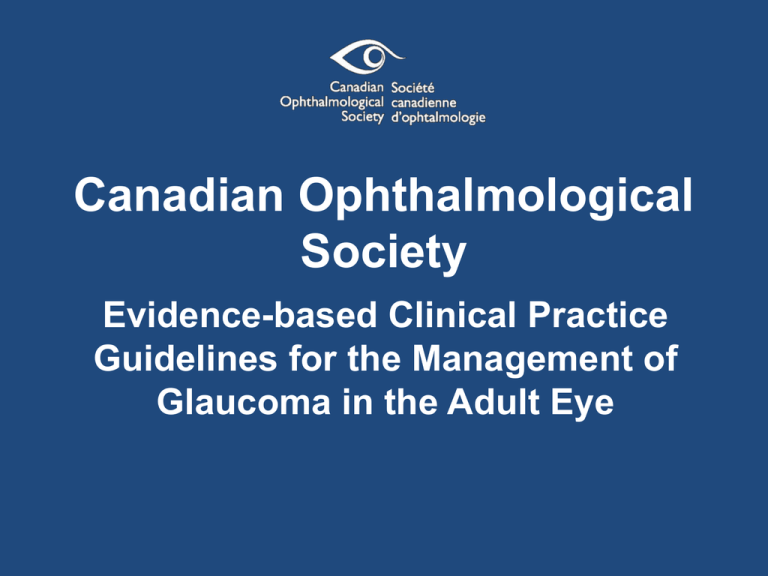
Canadian Ophthalmological Society Evidence-based Clinical Practice Guidelines for the Management of Glaucoma in the Adult Eye Canadian Ophthalmological Society Glaucoma Clinical Practice Guideline Expert Committee • • • • • • • • • Paul E. Rafuse, MD PhD FRCSC (Chair), Halifax, NS Yvonne M. Buys, MD FRCSC, Toronto, ON Karim F. Damji, MD MBA FRCSC, Edmonton, AB Paul Harasymowycz, MD FRCSC, Montreal, QC Caroline Lajoie, MD MSc FRCSC DABO, Quebec City, QC Frederick S. Mikelberg, MD FRCSC, Vancouver, BC Paul H. Murphy, MD FRCSC, Saskatoon, SK Marcelo Nicolela, MD FRCSC, Halifax, NS David P. Tingey, MD FRCSC, London, ON Canadian Ophthalmological Society evidence-based clinical practice guidelines for the management of glaucoma in the adult eye. Can J Ophthalmol 2009;44(Suppl 1):S1S93. Funding • Funding for the development of this guideline was provided by the Canadian Ophthalmological Society and the following sponsors, in the form of unrestricted educational grants: – – – – – Abbott Medical Optics Alcon Canada Inc. Allergan Canada Inc. Pfizer Canada Inc. Novartis Canada Inc. • Neither industry nor government was involved in the decision to publish guidelines, in the choice of guideline, or in any aspect of guideline development. • Clinical Practice Guideline Expert Committee members were volunteers, and received no remuneration or honoraria for their time or work. Canadian Ophthalmological Society evidence-based clinical practice guidelines for the management of glaucoma in the adult eye. Can J Ophthalmol 2009;44(Suppl 1):S1S93. Objectives These guidelines are intended to: • Provide guidance to Canadian ophthalmologists on the management of glaucoma in adults. • Advise users regarding patterns of clinical practice. These guidelines are not intended to: • Restrict innovation. • Provide a “cookbook” approach to medicine or to be a replacement for clinical judgment. • Be used as a legal resource, as their general nature cannot provide individualized guidance for all patients in all circumstances. Canadian Ophthalmological Society evidence-based clinical practice guidelines for the management of glaucoma in the adult eye. Can J Ophthalmol 2009;44(Suppl 1):S1S93. Methods Methods • Recommendations were formulated using the best available evidence with consideration of the health benefits, risks and side effects of interventions. • References used to support recommendations were assigned a level of evidence based upon the criteria used by other national organizations.1,2 • In the absence of direct evidence, recommendations were written to reflect unanimous consensus of the expert committee. • These guidelines were developed in accordance with the Canadian Medical Association Handbook on Clinical Practice Guidelines3 and the AGREE Instrument.4 1. Clinical Practice Guideline Expert Committee. Can J Diabetes 2008;32(suppl 1):S1–S201. 2. Canadian Hypertension Education Program. Available at: http://hypertension.ca. 3. Davis D, et al. Ottawa, ON; Canadian Medical Association; 2007. 4. AGREE Canadian Ophthalmological Society evidence-based clinical Collaboration. Available at: practice guidelines for the management of glaucoma in the http://agreecollaboration.org. adult eye. Can J Ophthalmol 2009;44(Suppl 1):S1S93. Criteria for assigning levels of evidence to the published studies Level Criteria Studies of diagnosis Level 1 i. Level 2 Independent interpretation of test results (without knowledge of the result of the diagnostic or gold standard) ii. Independent interpretation of the diagnostic standard (without knowledge of the test result) iii. Selection of people suspected (but not known) to have the disorder iv. Reproducible description of both the test and diagnostic standard v. At least 50 patients with and 50 patients without the disorder Meets 4 of the Level 1 criteria Level 3 Meets 3 of the Level 1 criteria Level 4 Meets 1 or 2 of the Level 1 criteria Canadian Ophthalmological Society evidence-based clinical practice guidelines for the management of glaucoma in the adult eye. Can J Ophthalmol 2009;44(Suppl 1):S1S93. Criteria for assigning levels of evidence to the published studies (cont’d) Level Criteria Studies of treatment and prevention Level 1A Level 3 Systematic overview or meta-analysis of high-quality randomized, controlled trials Appropriately designed randomized, controlled trial with adequate power to answer the question posed by the investigators Nonrandomized clinical trial or cohort study with indisputable results Randomized, controlled trial or systematic overview that does not meet Level 1 criteria Nonrandomized clinical trial or cohort study Level 4 Other Level 1B Level 2 Canadian Ophthalmological Society evidence-based clinical practice guidelines for the management of glaucoma in the adult eye. Can J Ophthalmol 2009;44(Suppl 1):S1S93. Criteria for assigning levels of evidence to the published studies (cont’d) Level Criteria Studies of prognosis Level 1 i. Level 2 Inception cohort of patients with the condition of interest, but free of the outcome of interest ii. Reproducible inclusion/exclusion criteria iii. Follow-up of at least 80% of subjects iv. Statistical adjustment for extraneous prognostic factors (confounders) v. Reproducible description of outcome measures Meets criterion (i) above, plus 3 of the other 4 criteria Level 3 Meets criterion (i) above, plus 2 of the other criteria Level 4 Meets criterion (i) above, plus 1 of the other criteria Canadian Ophthalmological Society evidence-based clinical practice guidelines for the management of glaucoma in the adult eye. Can J Ophthalmol 2009;44(Suppl 1):S1S93. Definition & Classification Definitions Ocular hypertension • IOP increases when there is obstruction to aqueous outflow. This occurs when: – the iridocorneal drainage angle is closed due to apposition of the trabecular meshwork and iris root (closed-angle), – there is obstruction to outflow through the drainage pathways of an open angle, or – when there is an obstruction to the venous drainage of the eye. Closed-angle glaucoma • Closed-angle glaucoma develops if the high IOP causes glaucomatous damage to the optic disc. Canadian Ophthalmological Society evidence-based clinical practice guidelines for the management of glaucoma in the adult eye. Can J Ophthalmol 2009;44(Suppl 1):S1S93. Definitions (cont’d) Open-angle glaucoma • Open-angle glaucoma occurs if damage to the disc is present in the face of an open angle. Idiopathic or primary glaucomas • These are open-angle or closed-angle glaucomas with no identifiable cause. Secondary angle closure glaucomas • These involve angle closure or elevated IOP with an identifiable cause. Gonioscopy is required to determine if the angle is closed, open or abnormal.1 1. Alwards WLM. Gonioscopy.org. Available at: http://www.gonioscopy.org/. Canadian Ophthalmological Society evidence-based clinical practice guidelines for the management of glaucoma in the adult eye. Can J Ophthalmol 2009;44(Suppl 1):S1S93. Classification • The most useful way to classify the glaucomas is according to anatomy and pathogenesis. • Elevated IOP is no longer part of the modern definition of glaucoma, but is associated with: – the development of glaucoma,1 – the prevalence of the disease in a population,2 and – the progression of the disease.3 • Lowering IOP therapeutically has been shown to reduce progression of VF loss in patients with glaucoma.3 • Clarifying the causes of IOP elevation is an important part of classifying and understanding the disease. Canadian Ophthalmological Society evidence-based clinical 1. Gordon MA, et al. Arch Ophthalmol 2002;120:714–20. practice guidelines for the management of glaucoma in the 2. Dielemans I, et al. Ophthalmol 1994;101:1851–5. adult eye. Can J Ophthalmol 2009;44(Suppl 1):S1S93. 3. AGIS Investigators. Am J Ophthalmol 2000;130:429–40. Gonioscopy — open and closed angles Recommendation Gonioscopy should be performed to determine if an elevated IOP is associated with an iridocorneal angle that is open, closed or structurally abnormal. Classification of the glaucoma on the basis of the appearance of the angle on gonioscopy will guide appropriate management [Consensus]. Canadian Ophthalmological Society evidence-based clinical practice guidelines for the management of glaucoma in the adult eye. Can J Ophthalmol 2009;44(Suppl 1):S1S93. Primary open-angle glaucoma suspects • An individual who is found on history and clinical examination to have: – optic disc features suspicious for GON, – suggestive VF defects, or – a constellation of risk factors for POAG that confer a heightened probability of developing the disease. • People with elevated IOP (>21 mm Hg), but with no evidence of GON or glaucomatous VF damage, would qualify as POAG suspects on the basis of having ocular hypertension. Canadian Ophthalmological Society evidence-based clinical practice guidelines for the management of glaucoma in the adult eye. Can J Ophthalmol 2009;44(Suppl 1):S1S93. Gonioscopy — secondary glaucomas Recommendation As many secondary glaucomas (e.g. PXF, neovascularisation, uveitis, and surgical trauma) can occur with angles that are either open or closed, careful gonioscopy is required to clarify the pathogenesis and management options [Consensus]. Canadian Ophthalmological Society evidence-based clinical practice guidelines for the management of glaucoma in the adult eye. Can J Ophthalmol 2009;44(Suppl 1):S1S93. Mixed and Multiplemechanism Glaucomas Multiple-mechanism glaucomas • Multiple-mechanism glaucomas occur when the cause of the elevated IOP is multifactorial with a number of possible influences of either, or both, open- and closed-angle mechanisms. • Examples include: – A patient with iritis, an elevated IOP, and an additional IOP response to the corticosteroid treatment. – A patient with known PXF glaucoma, or POAG, who suffers a central retinal vein occlusion and subsequent neovascularisation of the anterior segment. Canadian Ophthalmological Society evidence-based clinical practice guidelines for the management of glaucoma in the adult eye. Can J Ophthalmol 2009;44(Suppl 1):S1S93. Epidemiology and Burden of Blindness Epidemiology and burden of blindness • Glaucoma is the second leading cause (after cataract) of blindness worldwide, and is the number one cause of irreversible vision loss.1 • The prevalence of the various types of glaucoma follows racial and ethnic boundaries. • There may be approximately 409 0002 people with glaucoma in Canada. • Due to the asymptomatic nature of chronic glaucoma, up to 50% of those with glaucoma in the industrialized world are unaware of it and are not receiving care.3,4 1. Resnikoff S, et al. 2002. Bull WHO 2004;82:844–51. 2. Perruccio AV, et al. Can J Ophthalmol 2007;42:219–26. 3. Sommer A, et al. Arch Ophthalmol 1991;109:1090–5. 4. Mitchell P, et al. Ophthalmology 1996;103:1661–9. Canadian Ophthalmological Society evidence-based clinical practice guidelines for the management of glaucoma in the adult eye. Can J Ophthalmol 2009;44(Suppl 1):S1S93. Screening for Glaucoma Screening for glaucoma Recommendation It is recommended that population screening can be considered for high-risk populations. Screening should include both structural and functional measures of the disease. Screening for IOP alone should be avoided since it has low sensitivity, low specificity, and poor predictive value for the detection of glaucomas [Level 11–3]. Canadian Ophthalmological Society evidence-based clinical 1. Dielemans I, et al. Ophthalmol 1994;101:1851–5. 2. Sommer A, et al. Arch Ophthalmol 1991;109:1090–5. practice guidelines for the management of glaucoma in the 3. Mitchell P, et al. Ophthalmology 1996;103:1661–9. adult eye. Can J Ophthalmol 2009;44(Suppl 1):S1S93.
